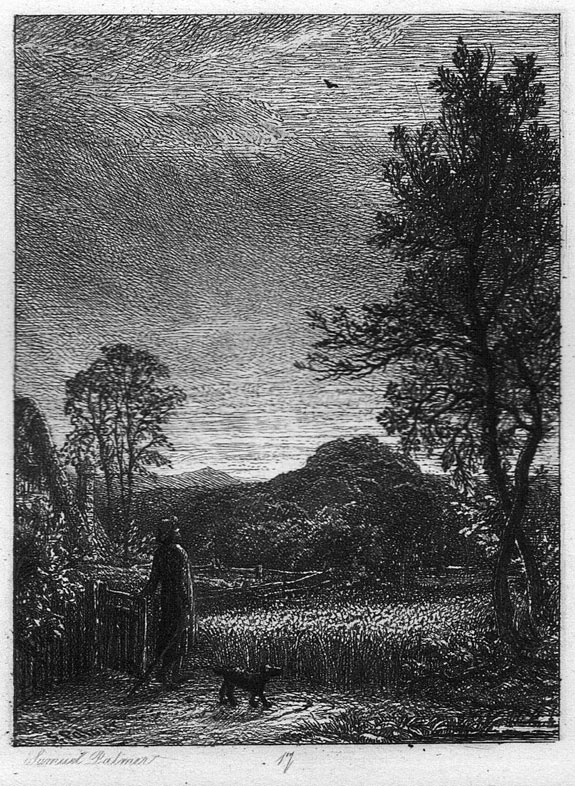|
Samuel
Palmer
(Newington,
south London 1805 – 1881 Redhill, near
Reigate, Surrey)
The
Skylark

a.
The Skylark
Alexander 2 vii/viii, Lister 2 vii/viii
120
x 98 mm (bevelled plate); 99 x 74 mm (image); 364 x
268 mm (sheet)
Etching
1850. The plate signed. Published state, as plate
17 in Etchings
for the Art Union of London by the Etching Club,
1857, edition of 500, the only issue. With the plate
number and Palmer’s name added in the lower
plate border. On laid india paper. Occasional foxing in the wide margins of the
wove support sheet. The sheet gilt-edged on three sides.
Sold
b.
The
Skylark
120 x 98 mm (plate); 99 x 74 mm (image);
245 x 192 mm (sheet)
A
duplicate impression (not illustrated). As above,
but the sheet trimmed in the margins. A pale fox
mark in the right plate border, other pale scattered
foxing in the margins away from the plate.
Sold
c.
The
Skylark
120 x 98 mm (bevelled plate); 99 x 74 mm (image);
122 x 98 mm (sheet)
Another
impression (not illustrated). As above, but trimmed
to the platemark. Surface problems verso, some
unevenness and adhering paper, not affecting the
obverse.
Sold
|
|
Additional
Information about the Print
Palmer’s
enthusiasm for etching having been awakened by
his membership of the Etching Club, he would
produce three more plates in 1850.
In The
Skylark, the first of these and though only
his second attempt in the medium, he established
his personal etching style, recapturing the vision
of the Shoreham years. The critic F G Stephens
wrote of it later in The Portfolio in
1872
The
refined spirit of this little gem of art and
poetry baffle words of description. Ineffable
is the way in which the rays of the sun interpose
between us and the ribbed clouds of fugitive night,
giving an idea of palpitation in perfect accord
with the outpouring of the voice of the bird, and
the awakening landscape.
The
subject is based on a Shoreham drawing of c1832, now in the National Museum of Wales,
which in 1843 Palmer had already taken up again
for a small oil panel. It reflects lines from
Milton’s L’Allegro
To hear the lark begin his flight,
And singing startle the dull night,
From his watch-tower in the skies,
Till the dappled dawn doth rise.
The
development of the etched image was painstaking,
the plate going through at least 6 states before
publication, the composition lengthened, a tree
introduced, a branch extended, the sky re-etched
etc.
In Life & Letters A
H Palmer records his father’s verbatum
account of his problems with the sky
“I remember …spending a whole day in nearly burnishing out …[the]
sky that was overbitten. The perverse acid would
bite skies and nothing else..."
and comments himself
what
I so much admire in it [is] the delicate upward
flush of early dawn over thin vaporous cloud, … the
result of the day's elbow-grease directed,
not by knowledge of any etching technicality,
but by knowledge of one of the most beautiful
effects in nature.
It
received its title of ‘The Skylark’ only
in 1857, for publication; previously Palmer referred
to it as “Dawn” though in 1850 the
Etching Club minutes referred to it simply as
The Lark when it was initially chosen for publication.
|